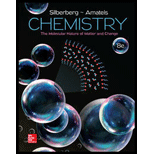
(a)
Interpretation:
The charge and full ground state electron configuration of the ion likely to be formed by
Concept introduction:
The electronic configuration of an atom describes how the electrons are ditributed in its atom among various shells and subshells. It is used to predict the chemical, physical, electrical and magnetic properties of the substance. The full electronic configuration of an atom tells about the distribution of electrons in the various atomic orbitals.
(b)
Interpretation:
The charge and full ground state electron configuration of the ion likely to be formed by
Concept introduction:
The electronic configuration of an atom describes how the electrons are ditributed in its atom among various shells and subshells. It is used to predict the chemical, physical, electrical and magnetic properties of the substance. The full electronic configuration of an atom tells about the distribution of electrons in the various atomic orbitals.
(c)
Interpretation:
The charge and full ground state electron configuration of the ion likely to be formed by
Concept introduction:
The electronic configuration of an atom describes how the electrons are ditributed in its atom among various shells and subshells. It is used to predict the chemical, physical, electrical and magnetic properties of the substance. The full electronic configuration of an atom tells about the distribution of electrons in the various atomic orbitals.
Want to see the full answer?
Check out a sample textbook solution
Chapter 8 Solutions
CONNECT ACCESS CARD FOR CHEMISTRY: MOLECULAR NATURE OF MATTER AND CHANGE
- What is the name of the following compound? SiMe3arrow_forwardK Draw the starting structure that would lead to the major product shown under the provided conditions. Drawing 1. NaNH2 2. PhCH2Br 4 57°F Sunny Q Searcharrow_forward7 Draw the starting alkyl bromide that would produce this alkyne under these conditions. F Drawing 1. NaNH2, A 2. H3O+ £ 4 Temps to rise Tomorrow Q Search H2arrow_forward
 ChemistryChemistryISBN:9781305957404Author:Steven S. Zumdahl, Susan A. Zumdahl, Donald J. DeCostePublisher:Cengage Learning
ChemistryChemistryISBN:9781305957404Author:Steven S. Zumdahl, Susan A. Zumdahl, Donald J. DeCostePublisher:Cengage Learning ChemistryChemistryISBN:9781259911156Author:Raymond Chang Dr., Jason Overby ProfessorPublisher:McGraw-Hill Education
ChemistryChemistryISBN:9781259911156Author:Raymond Chang Dr., Jason Overby ProfessorPublisher:McGraw-Hill Education Principles of Instrumental AnalysisChemistryISBN:9781305577213Author:Douglas A. Skoog, F. James Holler, Stanley R. CrouchPublisher:Cengage Learning
Principles of Instrumental AnalysisChemistryISBN:9781305577213Author:Douglas A. Skoog, F. James Holler, Stanley R. CrouchPublisher:Cengage Learning Organic ChemistryChemistryISBN:9780078021558Author:Janice Gorzynski Smith Dr.Publisher:McGraw-Hill Education
Organic ChemistryChemistryISBN:9780078021558Author:Janice Gorzynski Smith Dr.Publisher:McGraw-Hill Education Chemistry: Principles and ReactionsChemistryISBN:9781305079373Author:William L. Masterton, Cecile N. HurleyPublisher:Cengage Learning
Chemistry: Principles and ReactionsChemistryISBN:9781305079373Author:William L. Masterton, Cecile N. HurleyPublisher:Cengage Learning Elementary Principles of Chemical Processes, Bind...ChemistryISBN:9781118431221Author:Richard M. Felder, Ronald W. Rousseau, Lisa G. BullardPublisher:WILEY
Elementary Principles of Chemical Processes, Bind...ChemistryISBN:9781118431221Author:Richard M. Felder, Ronald W. Rousseau, Lisa G. BullardPublisher:WILEY





